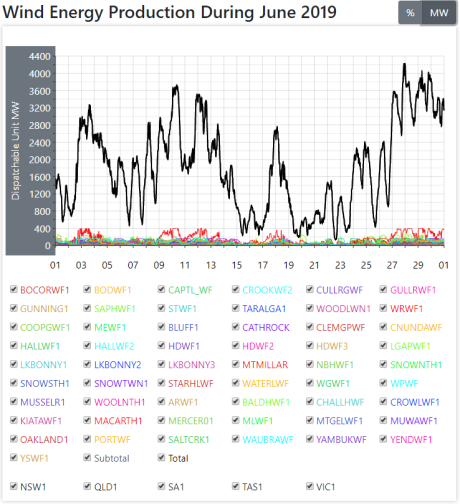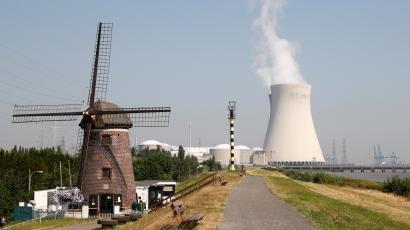Blown Away: Actual Wind Farm Output a Chaotic Fraction of Total Capacity
August 19, 2019 by 2 Comments

The renewable energy zealot occupies a world somewhere between fantasy and delusion, ignoring the consequences of sunset and calm weather. The mainstream media headlines still scream about a surge in wind or solar capacity, what they never talk about his actual output. And there’s a good reason for that.
The data above comes from Aneroid Energy and shows the output of every wind turbine connected to Australia’s Eastern Grid, situated from Far North Queensland, down through New South Wales, all over Victoria, Northern Tasmania and South Australia, with a combined notional capacity of 6,702 MW.
Notwithstanding its enormous geographical spread, Australia’s wind power fleet delivers an unreliable, chaotic and occasional source of electricity, often when and where it’s needed least; often collapsing without warning, when it’s needed most.
On numerous occasions, wind power output collapses in magnitudes of thousands of MWs, with the entire fleet often struggling to produce more than 400 MW or 6% of notional capacity.
If the same were true of Australia’s coal-fired power plants, Australians would spend more than half their time freezing or boiling in the dark. And yet, we’re repeatedly told that we’re well on our way to an all wind and sun powered future. It’s as if the collective has filed for divorce against reality.
Ronald Stein picks up the thread in an eerily reminiscent piece below.
Blown Away By Wind Farm Capacity Versus Actual Output
Eurasia Review
Ronald Stein
25 July 2019
Promises, promises. We’re constantly being blown away with the growing capacity of wind farms to provide renewable energy, but they’ve yet to produce anywhere near their projected capacity. Compounding their lack of production, is the intermittency of what they produce.
Lets’ be clear about what that means. First, it’s not renewable energy, it’s only renewable electricity, more accurately its only intermittent electricity. Renewables have been the primary driver for residents of Germany, Australia, and California behind the high costs of electricity. Second and most important is, electricity alone is unable to support militaries, aviation, and merchant ships, and all the transportation infrastructure that support commerce.
In Australia, they’re losing businesses, jobs, and money – the new definition of madness that’s becoming laughable stuff. Australians have become increasingly tired and frustrated with the wind movement. As such, voters went to the polls at their 2019 Federal Election, billed as a referendum on ‘Climate Change’, and voiced their opinions.
The Aussie Green/Labor Alliance promised an all wind and sun powered future with across the board subsidies for electric vehicles and household battery installations, subsidies for wind turbines, and subsidies for solar panels, and a crippling carbon dioxide gas tax, dressed up as a CO2 emissions reduction target, and an elevated directive for new cars to be electric.
The top-billed reason Green/Labor was supposed to fare so well at the polls, was Australians are, apparently, spending their every waking hour fretting about carbon dioxide gas and believing windmills and solar panels will save the day. Well, apparently not – Green/Labor duly lost the ‘unlosable’ election.
Australia has a total 6,558MW of wind farm generating capacity, the equivalent of three 2,200 MW San Onofre Nuclear Plants, spread from Far North Queensland, through NSW, across Victoria, Tasmania and South Australia. Despite that huge capacity, actual production has varied widely from a low of 400 MW to a high of 4,400 MW. Plus, all that actual production is intermittent electricity.
California is following Germany and Australia by phasing out its nuclear reactors, which have generated continuous uninterrupted zero emission electricity, in favor of intermittent electricity from wind and solar. In 2013 California shutdown the continuous nuclear facility of SCE’s San Onofre Generating Station which generated 2,200 megawatts of power and will be closing PG&E’s Diablo Canyon’s 2,160 megawatts of power in 2024.
The overall capacity of all wind turbines installed worldwide by the end of 2018 reached 597 Gigawatt according to preliminary wind power statistics published by the World Wind Energy Association (WWEA) All wind turbines installed capacity by end of 2018 will cover only 6% of the global electricity demand with actual production significantly less than rated capacity, and that’s only intermittent electricity.
Judging from the headlines, the world is on track to ratchet up renewable electricity and begin the rapid scale-down and ultimate phase-out of fossil fuels. Most energy analysts consider the fossil-fuel phase-out to be a scientific, economic and political fantasy, akin to levitation and time travel, but somehow the movement keeps making news.
The sad part is the ratchetting up renewables is not the call of energy analyst specialists, it’s the call of elected government officials and appointed government personnel supporting their decisions with less than accurate information.
Bear with me as we look at some energy numbers. Based on data, in 2018 the world consumed 11,865 million tons of oil equivalent (mtoe)
You might ask what is an MTOE? Well, it a unit of energy measurement. One million tons of oil equivalent (mtoe) is equal to the following alternatives for electricity generation:
- Fifteen hundred, YES 1,500 – 2MW wind turbines equals one mtoe, or
- Fourteen million, YES 14,000,000 – 295W solar panels equals one mtoe
Thus, the above represents the amount of carbon free energy needed to be deployed every day, yes, EVERY DAY, for each of those 11,161 remaining days until 2050 to replace fossil fuels in order to hit net zero carbon emissions by 2050.
The staggering bad news is that the above example is only what’s needed to replace current oil usage, as the example does not include new consumption especially from the 2.7 billion residents of China and India that are just starting to board the energy train and enjoy the lifestyles that energy and the products manufactured from those deep earth minerals/fuels most of the rest of the world is presently enjoying.
Seems obvious that we cannot rely on wind and solar expected outputs as they can realistically only provide a fraction of their capacity and then, only do it intermittently. Such intermittency requires fossil fuel backup for continuous uninterruptable electricity.
While everyone improves their efficient use of energy and implements conservation to the best of their abilities, the world needs to use the time to diligently develop new technologies to find an energy source or sources that are similar or superior to what deep earth minerals/fuels have been providing civilization. Hopefully those new sources will be abundant, and affordable.
Eurasia Review


No comments:
Post a Comment